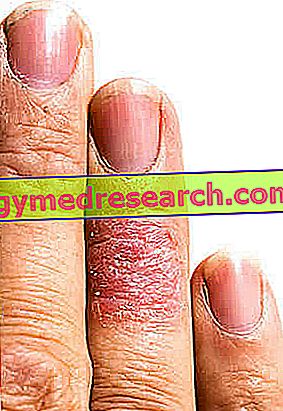Generality
Contact dermatitis is an inflammation of the skin triggered by interaction with irritants or allergens .
This dermatosis mainly affects people between the ages of 40 and 45, without any particular distinction between the sexes.

In most cases, contact dermatitis is caused by exposure to metals, particularly nickel and cobalt . However, it must be kept in mind that many other substances can trigger reactions of this type: from locally applied drugs to detergents, from tissues to cosmetic products.
On the basis of the determining causes and the clinical presentation characteristics, two forms of contact dermatitis are distinguished: irritative and allergic.
- Irritative contact dermatitis (DIC) is caused by repeated contact with solvents, cleaning detergents or industrial materials capable of damaging the skin, without the activation of the immunological response.
- On the other hand, allergic contact dermatitis (ACD) is caused by exposure to a substance (allergen) capable of triggering an immune reaction in previously sensitized subjects.
Contact with the irritating substance or allergen to which you are susceptible causes an inflammatory process which, within a short time (from a few minutes to 72 hours) triggers severe itching and burning in the affected area. Other cutaneous manifestations associated with contact dermatitis vary from erythema to vesicle formation, from desquamation to ulceration.
The diagnosis is formulated on the basis of medical history, physical examination and allergy tests (patch test).
Treatment generally involves the application of topical corticosteroids and removal from the triggering causes.
Predisposing factors
Several factors can increase skin susceptibility to the development of contact dermatitis:
- Chemical-physical properties, quantity and concentration of irritant / allergen substances, in addition to the duration and frequency of exposure;
- Individual characteristics related to skin resistance (weaker in children and the elderly);
- Stay in environments characterized by dry air, humidity and high temperature, which can promote cracking of the skin;
- Professional activities that expose to skin traumas, such as small wounds, abrasions and excoriations;
- Alterations of the skin barrier that facilitate the penetration of irritating substances / allergens (eg history positive for eczema and / or atopic dermatitis).
Causes and responsible substances
Contact dermatitis, also called contact eczema, can be distinguished by two variants:
- Irritative contact dermatitis (DIC);
- Allergic contact dermatitis (ACD).
Irritative contact dermatitis
The irritative form is responsible for 80% of all cases of contact dermatitis.
At the origin of this condition, a non-specific inflammatory reaction occurs (not on an immunological basis) against exogenous agents (coming from outside) of various kinds (chemical, physical or biological) that come into contact with the skin. In this location, these substances cause tissue damage with a direct mechanism .
Irritative contact dermatitis can affect any individual, as long as the irritating agent is sufficiently concentrated and fairly prolonged exposure.
The acute inflammatory reaction may develop following a single contact with the causal substance or after multiple exposures of short duration.
On the other hand, chronic contact irritant dermatitis is determined by prolonged contact with a low-potential irritant agent.
The substances most frequently involved in irritative contact dermatitis are represented by: acids, alkaline solutions, organic solvents, metal compounds, mineral oils, synthetic cooling lubricants, rubber additives, bituminous products, reactive components of plastic materials, soaps and detergents, physical agents mechanical, thermal and climatic.
A variant of irritative contact dermatitis, called phototoxicity, occurs following exposure to ultraviolet light due to the action of some locally applied photosensitizing agents (eg alcohol-based perfumes, essential oils, etc.) or taken orally ( eg psoralen, amiodarone and tetracycline).
Note : irritative contact dermatitis is more common among patients with atopic dermatitis; in such persons, the reaction to irritating substances may predispose to immunological sensitization, and therefore to allergic contact dermatitis.
Allergic contact dermatitis
Allergic contact dermatitis (ACD) is a cutaneous inflammatory process due to a cell-mediated type IV hypersensitivity reaction, induced by contact with one or more external agents ( allergens ) and by the intervention of immunological cofactors of the subject.
The phenomenon of sensitization typically develops in 2 phases:
- Exposure of the immune system to an antigen : in this phase, the allergens are picked up by the Langerhans cells (dendritic epidermal cells), which migrate to the regional lymph nodes where they process the antigen and present it to the T lymphocytes. After the first contact with the allergen, the sensitization process can be short (6-10 days for powerful sensitizers such as poison ivy) or prolonged (years for weak sensitizers such as sunscreens and cosmetics).
- Allergic reaction after re-exposure : in previously sensitized subjects, with each new re-exposure to the allergen, T cells are activated and migrate into the epidermis, releasing cytokines, recruiting inflammatory cells and causing the typical symptom of allergic contact dermatitis.
Numerous allergens are responsible for allergic contact dermatitis and cross-sensitization is frequent; therefore, reactivity to a substance may extend to other agents that have a close affinity for chemical composition or metabolic transformation on the part of the body; an example of cross-sensitization is the reaction between benzocaine and paraphenylenediamine.
In the same patient, allergic contact dermatitis can determine other phenomena, such as polysensitization, or sensitization to two or more chemically different allergens present in different products (eg topical metals and medicaments), or cosensitization . The latter occurs in relation to different products, but containing the same allergen (eg cosmetics and plants with the same perfumed essence) or to different allergens contained in the same product (eg chrome and cobalt in cement).
The following table provides a brief overview of the substances most frequently involved in the development of allergic contact dermatitis:
| Causes of allergic contact dermatitis | Examples |
| Cosmetics, perfumes and detergents | Vaseline (ointments and ointments), parabens (preservatives), paraphenylenediamine free base in hair dye (dye) and other compounds found in products for personal and home hygiene. |
| Chemicals used in the textile or footwear industry, in construction and in other industrial products | Many substances, such as epoxy resins, natural and synthetic textile fibers, dyes, dressers, rubber additives, leather and related glues, pesticides and formaldehyde in plastics and adhesives. |
| Metallic compounds, chromium, cobalt, mercury and nickel |
|
| Volatile substances | Various compounds present in the environment and transported by air in the form of vapors, gases, fumes, droplets and solid particles (eg glass fibers, perfumes, cement and wood dust). |
| Topical medications |
|
| Plants and vegetable substances | Poison ivy, rosin (derived from pine resin), balsam from Peru (sap of a South American plant used in the pharmaceutical and cosmetic industry) and ragweed pollen. |
Symptoms
Irritative contact dermatitis
Irritative dermatitis due to acute contact is manifested by symptoms such as pain and / or burning, while itching is reported less frequently. The skin reaction is limited to the site of contact with the irritant agent.
Other signs of irritative contact dermatitis may vary based on subjective reactivity and include: erythema, edema, papules, vesicles, boils, pustules, erosions and crusts.
Lesions can affect any body district, but the hands are the most frequently affected site due to manipulation and contact with potential irritants.
Irritative dermatitis due to chronic contact can occur with xerosis (dry skin), desquamation, hyperkeratosis and lichenification (skin thickening), sometimes accompanied by fissures (linear fissures of the skin).
Allergic contact dermatitis
The symptomatology that prevails in the different clinical forms of allergic contact dermatitis is itching; usually, the pain is caused by scratching and secondary infections.
Skin lesions usually appear in the area of contact with the allergen. Unlike the irritative forms, however, the manifestations can also extend, at a later time, to other regions of the skin that are apparently not exposed to the sensitizer (remote reactions), especially in the chronic forms. This happens because the T lymphocytes, which enter the bloodstream after the recognition of the allergen, can find traces of the substance previously left by other products in various parts of the body.
In acute contact allergic dermatitis, erythema, edema, formation of superficial vesicles with serous contents and desquamation (skin exfoliation) can be observed. In the more severe forms, with rapid onset, bullous lesions can be observed that can develop into large areas covered by ulcerations and squamous-crusted lesions.
Often, there are alterations that indicate, based on morphology or distribution, specific exposure, such as linear striae on arms or legs (eg following rubbing against poison ivy) or circular erythema (under a wristwatch or a belt).
If contact with the allergen persists, dermatitis tends to become chronic and lesions tend to spread. In chronic contact allergic dermatitis hyperkeratotic and lichenified plaques (with thickening and accentuation of the cutaneous design), sometimes associated with fissures, can occur.
Diagnosis
The diagnosis of contact dermatitis is based on the history and clinical situation observed at the time of the visit.
During the evaluation of the patient, all those factors that can determine contact with any allergens or irritants (personal and family pathological history, use of particular topical and cosmetic drugs, professional activity and any hobbies) must be taken into consideration.
The physical examination can further guide the diagnosis by focusing on:
- Time of debut;
- Type and location of lesions: irritative contact dermatitis is generally limited to the area of contact with the substance, while allergic contact dermatitis can extend to other areas, even distant from the primary focus;
- Presence of subjective symptoms: burning (DIC); itch (DAC).
In doubtful or recurrent cases, an epicutaneous test can be performed ( patch test ), which allows to identify with precision the groups of substances to which the patient is susceptible. This evaluation consists in the application - on healthy skin without clinical injuries in place (generally on the upper part of the back or on the fly surface of the forearm) - of an occlusive dressing containing a panel of agents potentially responsible for dermatitis.
The patch is left in place for 48 hours and is read after a further 24-48 hours, using a reading score ranging from 0 to +++ based on the intensity of the skin reaction. In the case of irritative forms, the patch tests will give a negative result or show a reddening of the skin area on which the patch used to perform the test was applied.
Another useful evaluation is the open test used to test products with a poorly defined composition, generally carried directly by the patient. The allergen is applied without occlusion directly on the skin of the forearm; the reading is carried out after 1, 48, 72 and 96 hours and, in case of allergic contact dermatitis, an edematous-vesicular erythema will be highlighted.
Treatment
The treatment of contact dermatitis varies according to the clinical phase and the location of the lesions.

The use of antihistamines is reserved for the control of possible itchy symptoms, since scratching favors the chronicization of eczema and bacterial overlaps. In the presence of an exudative or vesico-bullous component, it is also possible to associate local antiseptics or antibiotics (sodium hypochlorite, potassium permanganate, fusidic acid and mupirocin).
Other drugs with an immunosuppressive action, such as ciclosporin, are reserved for the more rare, widespread and / or resistant forms of conventional topical therapies.
In general, the prevention of the reaction itself by removing the causal agent is important.
Prevention
- When using substances suspected of being allergenic or irritating, it is recommended to wear protective equipment (such as gloves, specific clothing and masks).
- Use barrier creams and moisturizers to preserve the skin's hydrolipid mantle.
- When using a cosmetic for the first time it is good to test the tolerability to the same by placing a small amount in the hollow of the elbow, then observing if during 48 hours the skin becomes red or a wheal forms.
- Feeding on raw fruits and vegetables guarantees a high intake of vitamins useful for strengthening the body's resistance to irritants.



